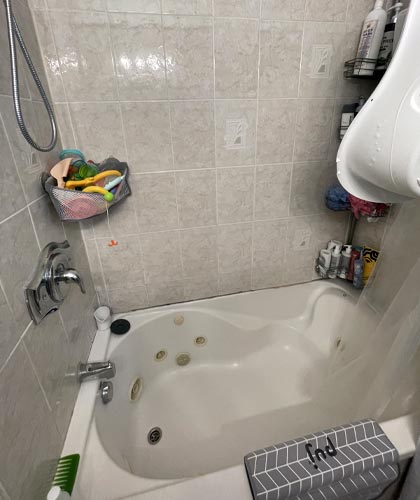Tips for Preventing Mold Growth in the Bathroom
The existence of mold in bathrooms can cause both health risks and damage to the infrastructure. Ensuring a sanitary and a mold-free bathroom requires focusing on appropriate ventilation and consistent upkeep. This article delves into efficient methods to stop mold proliferation in the bathroom. As your reliable ally in mold prevention and mold removal, Mold KO provides useful advice to help you establish a safe and mold-resistant environment in your bathroom.
Tips for Improving Bathroom Ventilation
To boost bathroom ventilation and lower the probability of mold formation, the following suggestions should be taken into account:
- Incorporating or Upgrading Exhaust Fans: If your bathroom doesn't have exhaust fans, it's advisable to install them. If fans are already in place, make sure they are functioning properly. If necessary, contemplate upgrading to more efficient models.
- Appropriate Fan Sizing and Placement: Locate the exhaust fan near the shower or bathtub to efficiently extract steam and humidity. Make sure the fan's size is suitable for the bathroom to optimize its ventilating performance.
- Consistent Cleaning and Upkeep: Regularly clean and service exhaust fans to guarantee they operate at peak performance. Accumulated dust and debris can hinder their moisture-removing efficiency.
- Make Use of Windows and Natural Ventilation: If your bathroom has windows, make sure you open them after taking a shower to foster air movement and lower humidity levels. Employing natural ventilation can substantially assist in mold prevention.
- Complement with Dehumidifiers: In bathrooms with few ventilation options or during h0umid weather conditions, deploying a dehumidifier can prove beneficial. Dehumidifiers pull out surplus moisture from the atmosphere, effectively lowering the overall humidity within the bathroom.
The Importance of Proper Ventilation
Effective ventilation serves as a cornerstone in managing the moisture balance within the bathroom. It facilitates the removal of excess humidity and enhances air circulation, thus curbing the accumulation of moisture that promotes mold development. Numerous ventilation alternatives, such as exhaust fans, natural ventilation via windows, and dehumidifiers, can significantly aid in minimizing moisture and warding off mold.
Maintaining a Mold-Resistant Bathroom
Apart from proper ventilation, maintaining a mold-resistant bathroom is essential. Implement the following practices to minimize mold growth:
- Regular Cleaning Routines: Establish a regular cleaning routine for your bathroom, focusing on areas prone to mold growth, such as shower walls, grout lines, and fixtures. Use mold-inhibiting cleaners and ensure thorough drying after cleaning.
- Properly Seal Grout and Caulking: Check and maintain the integrity of grout lines and caulking around sinks, showers, and tubs. Promptly repair or replace any damaged or deteriorated grout or caulk to prevent water seepage.
- Fix Water Leaks and Plumbing Issues: Address any water leaks, drips, or plumbing issues promptly. Even minor leaks can contribute to moisture accumulation and mold growth if left unresolved.
- Use Mold-Resistant Materials: When undertaking bathroom renovations or construction, it's worth considering the use of mold-resistant materials. These materials are specially engineered to combat mold proliferation and are especially beneficial in areas prone to moisture, such as shower walls and ceilings.
Additional Strategies for Mold Prevention
Beyond the suggestions previously outlined, here are some more actions you can take to further reduce the risk of mold formation in your bathroom:
- Dry the bathroom surfaces post-showering or bathing. This can help eliminate surplus moisture and deter mold growth.
- Employ mold-preventing products and cleaners. Such products can kill mold on hard surfaces and inhibit its growth.
- Swiftly remove wet towels and bathmats. Damp fabrics can contribute to heightened moisture levels in the bathroom, potentially leading to mold growth.
- Inspect and clean shower curtains and doors regularly. As these can serve as hotspots for mold, it's crucial to consistently check them and clean as necessary.
Here are some specific steps you can take:
- After showering or bathing, wipe down surfaces with a towel to remove excess moisture.
- Use a mold-inhibiting spray or cleaner on bathroom surfaces once a week.
- Remove wet towels and bathmats from the bathroom as soon as possible.
- Hang shower curtains to dry completely after showering or bathing.
- Inspect shower curtains and doors regularly for signs of mold growth.
- Replace shower curtains if they show signs of persistent mold growth.
Dealing with Existing Mold in the Bathroom
If you come across mold in your bathroom, it's imperative to act swiftly and effectively. Familiarize yourself with the signs of mold growth, such as black or green marks on surfaces, a musty smell, or respiratory issues. Smaller mold problems can often be addressed with a combination of water and detergent. However, for larger or stubborn mold issues, hire our mold remediation professionals at Mold KO to ensure a thorough and safe removal process.
Preventing mold formation in the bathroom is crucial for maintaining a healthy habitat and protecting the structural integrity of your dwelling. By utilizing the right ventilation practices, carrying out regular upkeep, and following mold prevention strategies, you can significantly decrease the risk of mold development. It's key to remain alert, promptly deal with any mold issues, and ensure a tidy and mold-resistant bathroom space. Mold KO is always on hand to aid you in achieving a mold-free home.
